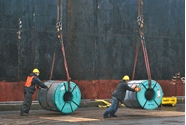Steel Products Prices North America

May Steel Imports Trending Toward 2.5 Million Ton Month
Written by John Packard
May 24, 2018
Based on the latest license data from the U.S. Department of Commerce reported earlier this week, we are expecting the trend for May steel imports to total 2.5 million to 2.6 million net tons. We continue to see strength in plate imports, in both coil and sheet. Finished imports are trending toward 2.1 million net tons, which if correct would be approximately 900,000 net tons lower than what was received during the month of April.
OCTG (oil country tubular goods), hot rolled, cold rolled, galvanized and Galvalume are all trending lower than what we saw in April.
Below is a table we use along with a graphic depicting how imports have been trending during the first 19-25 days of a month. What is shown is the daily import license rate, and the May rate is compared against that of April, March, February and January 2018. We are seeing a rising trend in hot rolled, coiled plate and cut plate. All of the other flat rolled items (shaded yellow items) are trending lower.

John Packard
Read more from John PackardLatest in Steel Products Prices North America

Nucor slows HRC price climb with $5/ton increase
After eight weeks of double-digit price increases on hot-rolled (HR) coil, Nucor slowed the price rise this week with an increase of $5 per short ton.

Domestic CRC prices surge ahead of imports
The price spread between stateside-produced CR and imports reached its widest margin in over a year.

Evraz raises plate prices $160/ton
Evraz North America (NA) has followed Nucor and SSAB with a plate price increase of its own: up $160 per short ton (st). The increase was effective immediately for all new orders of carbon, high-strength low-alloy, and normalized and quenched-and-tempered plate products, as well as for hot-rolled coil, the steelmaker said in a letter to […]

Nucor lifts HR coil to $820/ton
Nucor has increased its consumer spot price (CSP) for hot-rolled (HR) coil for a fourth consecutive week.

Nucor pushes HR spot price to $790/ton
Nucor increased its consumer spot price (CSP) for hot-rolled (HR) coil to $790 per short ton (st) on Monday, Feb. 10 – a $15/st bump vs. last week. The Charlotte, N.C.-based company has raised its weekly CSP by $40/st over the past three weeks after maintaining tags at $750/st since Nov. 12, according to SMU’s […]


